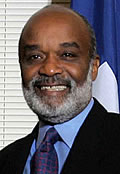URBAN STRATEGY TRAINING: Diclassified Document
< Previous | Home | Next >
Since the terrorist attacks of Sept. 11, 2001, the United States Agency for International Development (USAID) "has played an increasingly prominent role in the War on Terrorism."8 U.S. development programs are not directed toward the population that most needs them, but rather to the most "at-risk populations and regions," according to Pentagon strategy.
For military strategists like U.S. Army Colonel (Ret.) Thomas Baltazar, USAID programs "can play a crucial role in denying terrorists sanctuary and financing by diminishing the underlying conditions that cause local populations to become vulnerable to terrorist recruitment.
Moreover, USAID programs directed at strengthening effective and legitimate governance are recognized as key tools with which to address counterinsurgency."
The Pentagon's strategy is to assure security for the United States, and to this end, it uses "democracy" and "development assistance" as complements to military operations.
The U.S. National Security Strategy maintains that "development reinforces diplomacy and defense, reducing long-term threats to our national security by helping to build stable, prosperous, and peaceful societies."9
Urban peripheries in Third World countries have become war zones where states attempt to maintain order based on the establishment of a sort of "sanitary cordon" to keep the poor isolated from "normal" society.
"Army sources confirmed that techniques employed in the occupation of the Morro da Providéncia favela [slum] are the ones Brazilian soldiers use in the United Nations peacekeeping mission in Haiti."1
According to the newspaper, "in exchange, the Army is gathering information on the slum and its inhabitants.
Soldiers filmed and photographed the meeting and the entire troop deployment." General Soares made all those promises in order to "diffuse the revolt by community leaders against the social project programmed for the slum."
But the news published by the daily Estadão de São Paulo goes farther in revealing the military's modus operandi.
The commander of the 9th Motorized Infantry Brigade in Haiti, William Soares, directed the occupation of Morro da Providéncia by 200 soldiers, who installed machineguns on "the community's only plaza, transformed into a military base," which were later withdrawn in order to facilitate a dialogue with the population.
In the meeting with the Residents Association [Asociación de Pobladores], General Soares "promised projects, a Christmas party with gifts for the children, a vacation camp, film screenings, medical, and sanitation assistance." This admission by Brazilian armed forces largely explains the interest of Lula da Silva's government in keeping that country's troops on the Caribbean island: to test, in the poor neighborhoods of Haiti's capital, Port-au-Prince, containment strategies designed for application in the slums of Rio de Janeiro, São Paulo, and other large cities.
Urban theorist Mike Davis analyzes urban peripheral areas in terms of a commitment to social change.
A single sentence synthesizes his analysis: "It's the slum peripheries of poor Third World cities that have become a decisive geopolitical space."2 He asserts that Pentagon strategists are lending great importance to urban planning theory and architecture, since the peripheries are "one of the most challenging terrains for future wars and other imperialist projects."
Wilgeens Rosenberg, February 23 2008, 4:05 PM
Start a NEW topic or,
Jump to
previous | Next Topic >
< Previous | Home | Next >
< Previous | Home | Next >

 Rene Preval in Canada
Rene Preval in Canada  Rene Preval and Dominique de Villepin
Rene Preval and Dominique de Villepin  Rene Preval and Leonel Fernandez
Rene Preval and Leonel Fernandez  Rene Preval and Condoleezza Rice
Rene Preval and Condoleezza Rice  Rene Preval and Fidel Castro
Rene Preval and Fidel Castro  PHOTO: Haiti President Rene Preval and Bill Clinton in New York
PHOTO: Haiti President Rene Preval and Bill Clinton in New York  Rene Preval and Josette Sheeran
Rene Preval and Josette Sheeran  President Rene Preval
President Rene Preval  Presidents Rene Preval, Raul Castro, Daniel Ortega, and Leonel Fernandez
Presidents Rene Preval, Raul Castro, Daniel Ortega, and Leonel Fernandez  Rene Preval and Hugo Chavez
Rene Preval and Hugo Chavez  Trinidad Obama Dissed Preval Nouvelle Tournure New Twist
Trinidad Obama Dissed Preval Nouvelle Tournure New Twist  Caribbean News From Caribworldnews
Caribbean News From Caribworldnews  Bringthepai Preval Kout Soulye
Bringthepai Preval Kout Soulye  New Haitian President Rene Preval Visit to United States
New Haitian President Rene Preval Visit to United States  Rene Preval Sworn In As Haiti's New President, Jeb Bush
Rene Preval Sworn In As Haiti's New President, Jeb Bush 

